Refunds and returns management for furniture purchases is a customer service process, but it is also an essential aspect of any retail or e-shop business. With expensive ticket prices, complicated delivery logistics, and customer expectations on a steady rise, your returns and refunds for furniture processes can make or break brand loyalty.
As with any small consumer product, returning furniture is often difficult because of its size, weight, and susceptibility to breakage during transit. Customers also might want to return pieces because they don’t coordinate with their home décor or don’t fit in their space, even if the item isn’t defective. Therefore, it becomes imperative for businesses to have clear, fair, and transparent return and refund policies in place.
Whether a traditional retail business or a digital-first furniture brand, a proper process makes everything run smoother, customers happier and losses lower. In this article, we will give you an overview on how to manage refunds and returns for furniture purchases, outlining common return scenarios, the main building blocks of a good return policy, refund best practices, as well as a few techniques to improve your sales and avoid getting returns.
What Makes Returns and Refunds for Furniture Complicated?
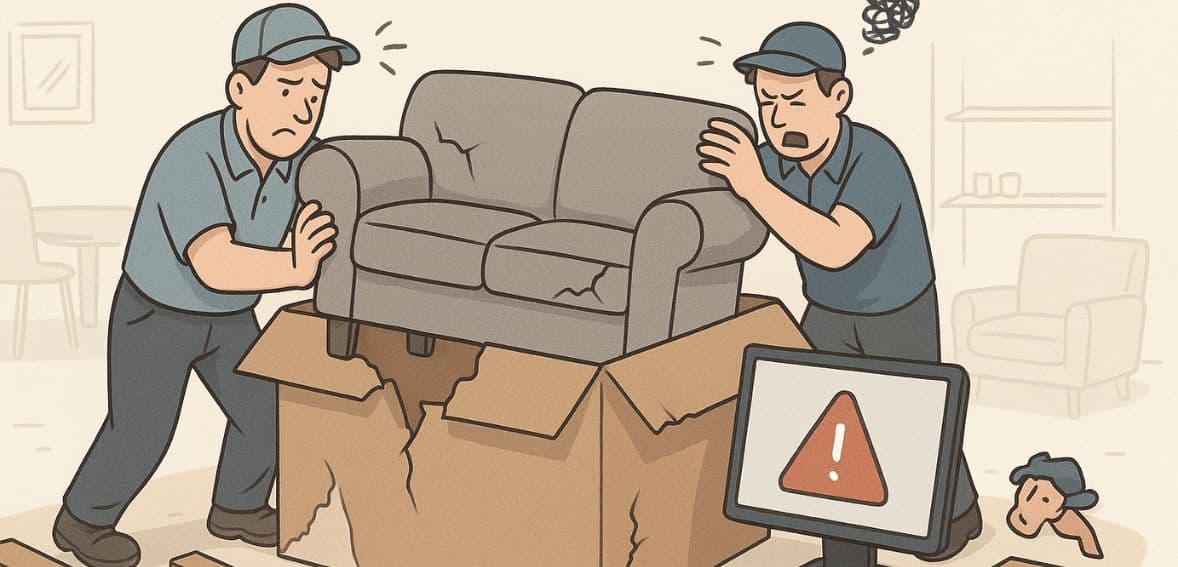
Returning furniture is more complicated than returning everyday items such as clothes or electronics. First, because furniture is heavy and bulky, shipping can be costly and take time. Organizing pickups, coordinating carriers, and packaging items correctly complicate the operation even further.
And the other challenge is the risk of damage in the return transit. Even assuming that a customer packs the furniture carefully, there’s no guarantee that it will return in a resalable condition. Minor scratches, dents, or broken parts often mean that the item can’t be sold again at full price — or at all.
Many furniture pieces also require assembly and disassembly, resulting in a high chance of damage or missing parts. If a customer has put the item together and later returns it, the seller could well struggle to repack it and sell it again.
Finally, furniture is very personal and space-dependent. Even if the product is exactly what the description claims, it may not be right for the customer’s space or expectations. Fairly managing these subjective complaints, without damaging the bottom line, is what makes returns and refunds for furniture in furniture uniquely difficult.
Common Return Scenarios in Furniture Sales
Returns and refunds for furniture can happen for all kinds of reasons, many of which are no fault of the seller. Knowing common situations helps businesses plan and react properly.
Damaged Upon Delivery:
This is an issue that happens the most. Rough treatment during shipping can cause items to show up with scratches, broken parts or torn fabric. Customers expect immediate resolution through replacement or refund.
Product Does Not Meet Description:
If the color, texture or material appears different from what customers saw online, they might feel misled. Even minor differences in finishing or shade can lead to dissatisfaction.
Wrong Size or Fit:
Even with a small dimension, customers still miscalculate or misinterpret its size, leaving them with items that take up too much space.
Change of Mind:
Customers may decide they shouldn’t have bought it after delivery, especially if it’s too big, doesn’t go with the other décor or just feels wasteful.
Incomplete or Missing Parts:
Flat-pack furniture usually comes with hardware or components that may be missing or misconfigured, rendering it impossible to assemble the final piece.
Defects Found After Some Use:
In the long term, even minor manufacturers’ defects—even in budget or mass-produced items—can rear their ugly heads, such as wobbly legs, uneven surfaces or squeaky joints.
The ability to anticipate such scenarios enables businesses to create policies that are equitable to customers and manageable for operations.
Key Components of an Effective Return Policy
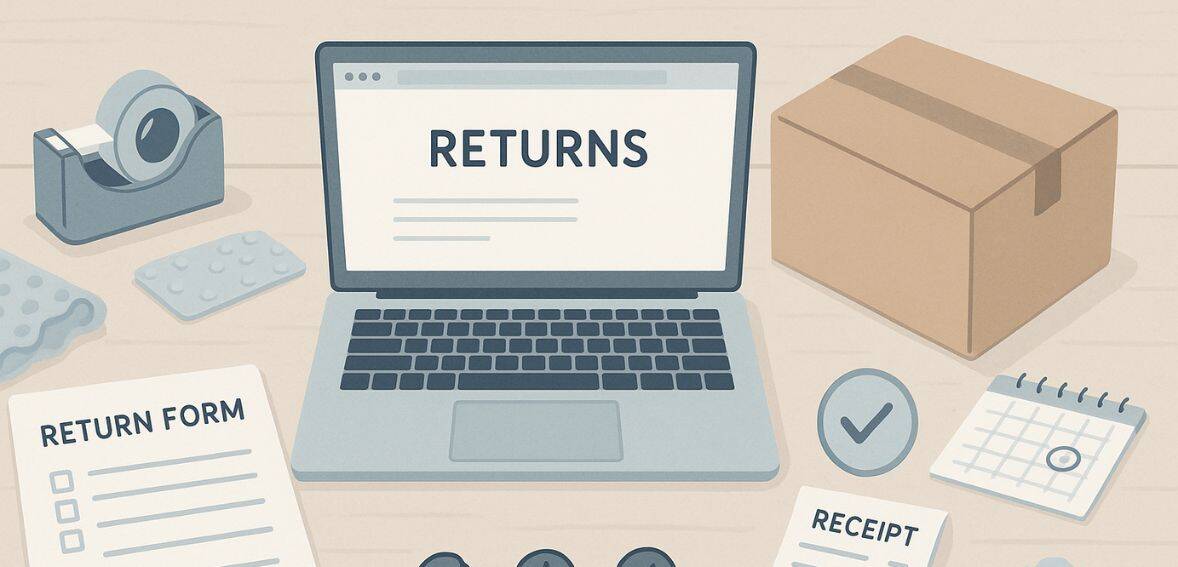
Proper returns and refunds for furniture policy establishes expectations for customers and the store alike. It prevents misinterpretations, reduces disagreements, and fosters trust. You want to include the following key components:
Timeframe for Returns:
Clearly define the period customers have to return an item — general return windows are 7, 14, or 30 days after the delivery. Some brands even expand this during holiday seasons or promotional offers.
Condition Requirements:
Be explicit about the state of goods that can be returned. Most policies say items must be unused, undamaged, and in their original packaging. For built products, clarify if they have to be disassembled for return or if restocking fees apply.
Proof of Purchase:
Emphasize that a receipt or order confirmation is required. And this helps in validating that transaction and making the return process seamless.
Restocking and Return Shipping Charges:
If you have a restocking fee, clearly state it. Be clear about who pays for return shipping — especially with large furniture pieces. Some businesses will subtract this expense from your refund.
Exceptions and Non-returnables
Specify what cannot be returned (custom-made furniture, clearance merchandise, merchandise that was damaged when used improperly). It can help you avoid any confusion.
Refund or Exchange Options:
Determine on a case-by-case basis, and if possible, give customers the option of a full refund, store credit, or exchange. This affords them flexibility and enhances satisfaction.
Communication Process:
Be very clear about how to start a return, who to contact, as well as when they can expect to hear back. A good return policy is easy to locate, easy to read, and creates a fair arrangement for both parties.
In-Store vs Online Furniture Return Management
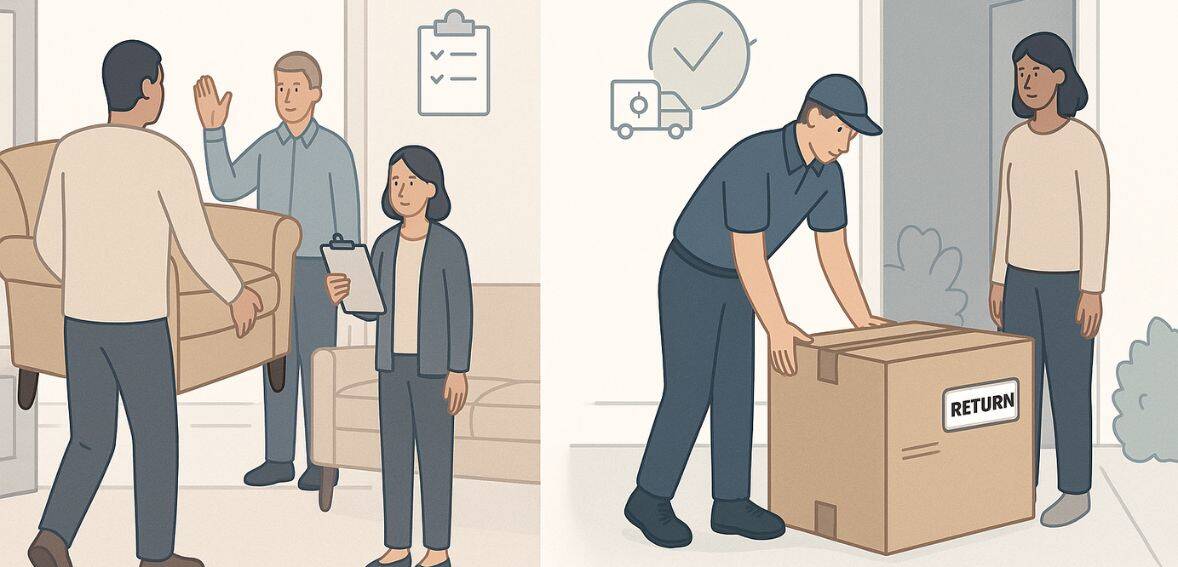
Returns and refunds for furniture can be managed quite differently in-store and online. Each channel presents specific challenges and opportunities that need to be considered in the return process.
In-Store Returns:
For brick-and-mortar stores, returns are generally less complicated. Customers can return the furniture directly to the store, where staff can examine the item on site and provide an online exchange or refund instantly. The primary benefit in this scenario is control — stores are going to be able to measure damage in person and eliminate ambiguity. But taking a large piece of furniture back to the store can be a challenge for the customer, and that can discourage returns altogether.
Online Returns:
In the case of online purchases, things get trickier. Because the customer isn’t able to touch and feel the product before purchase, there’s a higher return rate. These returns demand reverse logistics — scheduling pickups, offering shipping labels and examining returned goods from a distance. Many businesses will ask for photographic evidence or video submissions before they authorize a return. The process also must account for lag time, increased shipping costs and the risk of damages during return transit.
In order to make the online retail business successful, consumers need a comprehensive, automated return process, clear instructions about packaging, and a supportive team. Businesses team up with a third-party logistics (3PL) firm or implement return management software to simplify this process.
Recognizing these differences allows businesses to tailor policies by channel, enabling people to return things in a hassle-free, customer-friendly way, no matter how the item was purchased.
Establishing an Easy Return Process
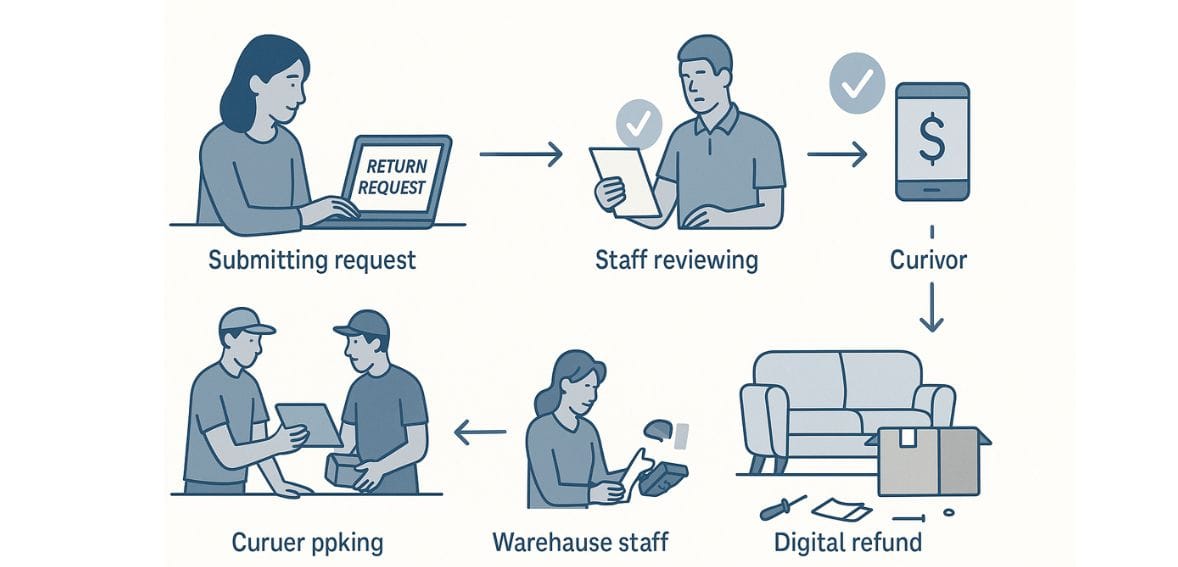
A seamless return process isn’t just about efficiency—it’s about reducing friction for the customer and saving time and resources for your team. A smooth, transparent system builds trust and encourages future purchases, even after a return.
Here’s how to create a return process that works:
Step 1: Return Request Initiation
Customers should be able to initiate a return easily, either through an online return portal or by contacting customer service. Include a form that collects necessary details like order number, reason for return, photos (if applicable), and preferred resolution (refund, replacement, or credit).
Step 2: Review and Approval
Once the request is submitted, your team should review the case within 24–48 hours. If photos show clear damage or mismatched items, approve the return and provide next steps. For “change of mind” cases, apply the return policy terms (e.g., restocking fees).
Step 3: Shipping Coordination
Offer a prepaid return label or coordinate a pickup for larger items. Provide packaging instructions to minimize return damage. For local deliveries, a reverse pickup by your own team may be ideal.
Step 4: Inspection and Documentation
When the item arrives, inspect it for compliance—check condition, parts, and packaging. Document everything with photos for internal records, especially if you’re issuing a partial refund.
Step 5: Final Refund or Credit
Process refunds quickly, ideally within 5–7 business days. Clearly communicate how and when the refund will be issued, especially if restocking or shipping fees are deducted.
By keeping the customer informed at every step, you build confidence and reduce frustration, even if the purchase didn’t work out.
Handling Refunds Smoothly
Refunds are usually the last step in the return process, and the way you handle refunds and exchanges can create a permanent impression. The refund process is smooth, which builds trust and can lead to future purchases even if the item was not kept by the customer.
Refund Timelines:
Explain how long it takes for refunds to process. Credit card and digital wallet refunds usually show up in 5–10 business days; bank transfers may take longer. Set expectations clearly and follow through without delays.
Payment Method Matching:
Always refund to the original payment method unless the customer explicitly requests an alternative, like store credit. This adds security and prevents fraud.
Communication Is Key:
Once inspected, advise the customer that the item has been received and if the refund is full or not. If it deducts restocking fees or the cost of return shipping, make that clear up front.
Handling Partial Refunds:
Show evidence to back up the deduction to the furniture payment merchant statement — photos or inspection notes to help minimize disputes.
Offering Store Credit:
Store credit may be a more satisfying option for some customers, particularly if they intend to make another purchase anyway. You can offer them a bonus amount if you offer a store credit, e.g., 10% extra, so that a few of them stay loyal.
Be Transparent and Empathetic:
Your aim should be to leave a customer with a positive experience. That makes it more likely they’ll purchase from you again.
Managing Customer Expectations and Disputes
Regardless of how clearly your returns and refunds for furniture policy is defined, disputes can still happen. Some customers may demand full refunds for ineligible items. Others may be concerned about restocking fees or shipping and handling. That’s why setting expectations from the start is vital.
Set Expectations Early:
Make sure to show your return policy prominently on your product pages, checkout screens, invoices, and email confirmations. Use bullet points and plain language to clearly outline timelines, conditions, and exceptions.
Train Your Team:
Customer service representatives need to be familiar with your policies. Train them to be empathetic but also to follow business rules when dealing with frustrated customers. Empower them to provide solutions such as a discount, credit or accelerated support when appropriate.
Keep Documentation Handy:
Never forget to document phone calls, verifications of receipt, conditions, and confirmations. This evidence can help you resolve the issue quickly, especially when it comes to payment platforms or chargeback claims.
Offer Reasonable Flexibility:
Occasionally, a goodwill refund—even if the return is technically outside your policy—can turn a disappointed buyer into a lifelong customer. Be judicious, but don’t be completely inflexible.
Even if things don’t go perfectly, resolving disputes with transparency and care helps build your brand reputation.
How to Reduce Return Rates in the First Place?
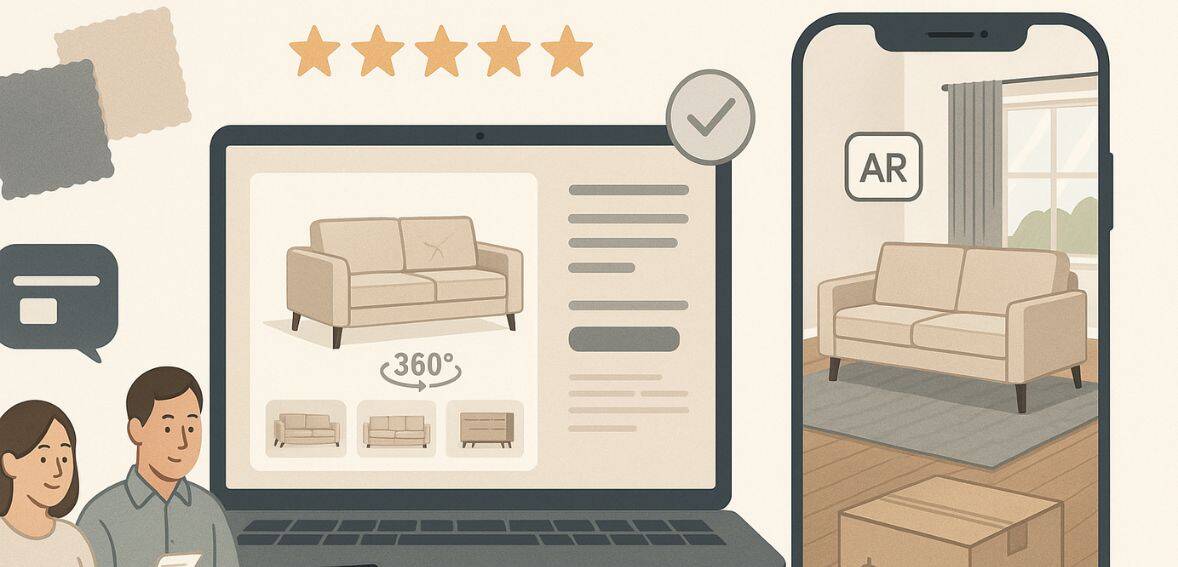
Having a solid return process is important, but reducing return rates is even better for your bottom line. Fewer returns will cause lower shipping costs, fewer refunds, and customers who are more satisfied. Here is a way to reduce unneeded returns:
Ensure Accurate Product Descriptions:
List exact dimensions, weight, materials, care instructions, etc. Describe any natural variations (like wood grain) that might surprise buyers.
Use good-quality photos and videos:
Vary the angles of the furniture and styles of rooms in which they might appear in real life. At the same time, shoot close-ups of textures and finishes. Even better, use videos or 360-degree views to help customers feel confident before they purchase.
Provide Augmented Reality Tools or Room Visualizers:
Using augmented reality or virtual staging tools will allow customers to see how furniture will look in their space. There’s less opportunity for mismatched expectations about size, color, and style.
Promptly Respond to Pre-Purchase Questions:
Provide live chat, FAQs, or customer reviews that answer common questions. The more informed your buyer, the less likely they’ll return the item.
Encourage Customer Reviews and Photos:
Use real people with the product in their houses. Honest reviews with user-generated content to keep it real.
Teach Assembly and Maintenance:
Provide guides, videos, and tips to help with assembly and care. The prevention of misuses or incorrect assembly of the product minimizes post-purchase problems.
Offer Swatches or Samples:
For higher-end or bespoke pieces, after-purchase samples for punching up the fabric to send. This avoids returns, for color or texture, that do not match.
By being educational and transparent, you empower customers to make the right decision from the start, and limit expensive returns down the line.
Conclusion
No doubt it is painful dealing with furniture returns and refunds. If done correctly, your return policy transforms into a powerful customer service tool rather than just an escape plan.
You can turn potentially bad experiences into experiences of trust and loyalty by being transparent, responsive, and flexible. Your customers will appreciate the clarity you have in your policies, and it will be easy for them to return things that didn’t quite end up being for them. That appreciation in turn often leads to repeat business and referrals.
In parallel, a proper process protects your company from losses. You’ll spend less time, reduce shipping waste, and protect your product margins. Armed with the right tools and team training, you can process returns with efficiency and poise.
And keep in mind — every return is a chance to learn. Ultimately, it comes down to balance. Effective return management helps your customers, preserves your profits, and enables your brand to become even stronger, one happy customer at a time.
Frequently Asked Questions to Manage Refunds and Returns for Furniture Purchases
- What is the typical return window for furniture purchases?
Most furniture retailers offer a return window of 7 to 30 days from the delivery date. This can vary based on the store’s policy, the type of product, and whether it’s custom-made. - Can I return the assembled furniture?
It depends on the store policy. Some stores allow returns if the item is in like-new condition, even after assembly, while others may charge a restocking fee or reject the return entirely. - Who pays for return shipping on large furniture items?
Return shipping for bulky items is usually the customer’s responsibility, unless the item arrived damaged or there was a mistake in the order. Always check the policy before purchasing. - What should I do if my furniture arrives damaged?
Take clear photos of the damage immediately and contact customer service. Most retailers will arrange a free replacement, repair, or refund depending on the severity of the issue. - Are custom or clearance items returnable?
Custom, made-to-order, or clearance items are often non-returnable unless they arrive damaged or defective. Always review the store’s policy before making such purchases.
